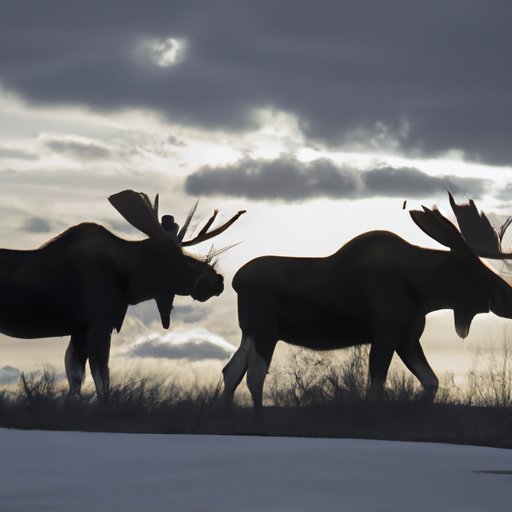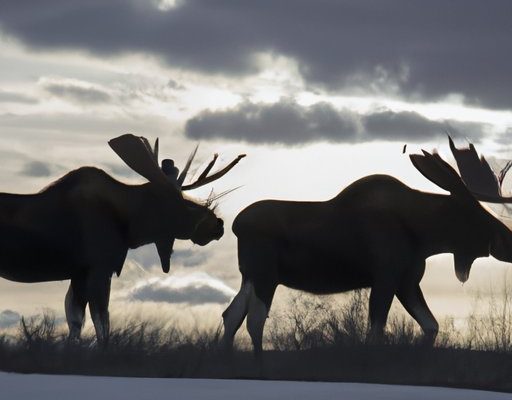
Imagine being in the woods, eyes scanning the surroundings. Suddenly, you catch sight of a large creature—could it be a moose? Or perhaps it’s one of its close relatives or look-alikes? Understanding these animals not only enhances your appreciation of nature but also helps you identify them accurately. In this article, we’ll dive into 10 animals similar to the moose and highlight what makes each one unique. Grab a warm drink, and let’s explore!
1. Elk
Elk, or wapiti, are often confused with moose due to their size and antler structure. Standing over five feet tall at the shoulder, they’re one of the largest deer species. While both animals roam North America, the elk prefers mountainous areas.
What to Look For:
– Elk have a more slender, taller build compared to the stockier moose.
– Their antlers are typically long and pointed, whereas moose antlers are flat and wide.
– The coloration is another hint; elk often have a lighter tan coat with darker legs.
So, next time you’re out hiking, pay close attention to their features. You might spot a herd of elk rather than moose!
2. Reindeer
You might be surprised to learn that reindeer, also known as caribou in North America, belong to the same family as moose: Cervidae. While they are much smaller than moose, they have some similarities, particularly in antler shape.
Identifying Features:
– Reindeer’s antlers are typically more branched and not as broad as those of a moose.
– They have a distinct fur coloration that varies from brown to gray, often with a lighter underbelly.
– Unlike moose, which have a pronounced hump on their shoulders, reindeer have a more balanced silhouette.
If you’re ever wandering through snow-covered terrain, the sight of a reindeer can feel like a magical moment!
3. Caribou
While technically the same species as reindeer, caribou are known for their migratory patterns. They travel vast distances in herds, making them fascinating to watch.
How to Differentiate:
– Caribou are generally smaller than moose and have a more delicate build.
– Their antlers, which both males and females boast, have a unique branching pattern.
– Look for their distinct furry noses, which are different from the moose’s more elongated, darker snout.
If you’re in the Arctic regions, keep an eye out for these impressive animals. Their migration can be a breathtaking sight.
4. Bison
Bison are massive creatures that can weigh up to 2,000 pounds. Though they don’t live in the same habitats as moose, their size can lead to misidentification from a distance.
Key Characteristics:
– Bison have a large, hunched back and a shaggy coat, especially in winter.
– Unlike moose, bison don’t have antlers; instead, they have a set of thick horns.
– The facial profile of a bison is more rounded compared to the moose’s elongated appearance.
If you’re ever in the Great Plains, catching a glimpse of a bison herd can feel monumental!
5. Sika Deer
Originating from East Asia, sika deer are smaller members of the deer family but share some physical traits with moose. They are known for their distinctive spotted coats.
How to Tell Them Apart:
– Sika deer are smaller and more slender compared to a moose.
– Their spots are a significant giveaway, as moose have a solid-colored coat.
– While moose have wide, palmate antlers, sika deer boast more typical branching antlers.
These deer can add a hint of elegance wherever they roam, making them a delightful find in the wild.
6. Water Buffalo
While water buffalo are not native to North America, their size and shape can be reminiscent of moose, especially in marshy areas.
Distinctive Traits:
– Water buffalo have large, curved horns and a bulky body.
– They usually reside in wetlands, contrasting with the moose’s preference for boreal forests.
– Their coat is usually dark, and they have a much more rounded shape than moose.
If you find yourself near wetlands in Asia, spotting a water buffalo can be a unique experience!
7. Asian Moose (Alces japonicus)
Yes, there’s another moose variant! The Asian moose, native to Siberia and parts of Japan, shares many similarities with its North American relative but has some key differences.
What’s Different:
– Asian moose tend to have darker fur and are slightly smaller than their North American cousins.
– Their antlers can have a slightly different shape, often with more pronounced brow tines.
– Geographic location can be a big indicator; if you’re in Asia, you’ve most likely spotted an Asian moose!
Understanding these subtle differences can enrich your nature experiences.
8. Tapir
Tapirs are unique, somewhat odd-looking animals that can be mistaken for small moose. They have a stocky build and short legs, making them resemble moose in shape but not behavior.
Identification:
– Tapirs have a long, flexible snout unlike the moose’s broader nose.
– Their body is more compact, and they have a more rounded shape.
– They don’t have antlers at all, which is a definitive difference from moose.
If you’re in Central or South America, spotting a tapir adds an interesting twist to wildlife watching.
9. Nilgai
Nilgai, also known as blue bulls, are the largest antelope species in India. Their unique shape and size can lead to confusion for those unfamiliar with them.
Key Differences:
– Nilgai have a pronounced shoulder hump and are quite slender, unlike the more stocky moose.
– They have short, straight horns, while moose boast palmate antlers.
– Their bluish-gray coloration sets them apart, providing an interesting visual divergence from the typical brown of a moose.
If you’re wandering through the grasslands of India, keep your eyes peeled for these intriguing animals.
10. Capybara
While capybaras are definitely on the smaller side, they share the same family as moose—Cervidae. These social creatures are often found near water bodies and have a unique shape that might catch the eye.
How To Spot Them:
– Capybaras have a more rounded, stout body and lack antlers entirely.
– Their fur is short and coarse, differing significantly from the long-haired moose.
– These animals are much smaller, usually weighing around 100 pounds, making them easy to identify as not being moose.
If you’re in South America, finding a capybara lounging by the water is an adorable sight!
Exploring the animal kingdom can feel like a treasure hunt, especially when you come across creatures that resemble moose. From the stately elk to the curious capybara, each of these animals has its own unique charm and story.
Understanding how to tell these animals apart not only enhances your outdoor adventures but also deepens your connection to nature. The next time you’re out in the wild, take a moment to appreciate the diverse wildlife around you. You never know what fascinating creature you might encounter! So, keep your eyes open, your camera ready, and enjoy the exploration!

